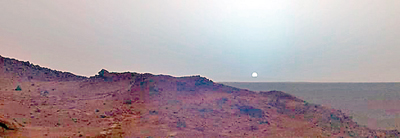The Age of the Space Probe
Landing on Mars has never been a simple thing. The Soviet Union, who were the first to try, tried eight times to get a robotic explorer on to Martian soil. Only, the Mars 3 probe managed to transmit from the surface for 90 seconds in 1971.
The Americans were more successful, Mariner 4 did a successful flyby in 1965, returning 22 images of the surface. Unfortunately, there was no sign of a civilisation of canal builders on the stark, cratered surface.

Martian Sunset in 2005, taken by Spirit
In 1971, Mariner 9 probe became the first spacecraft to go into orbit around Mars, imaging the giant volcanoes of the red planet among other things.
Viking 1 was the first to actually make contact with the planet’s surface, touching down on the western slopes of the smooth plain of Chryse Planitia on July 20, 1976. Viking 2 followed soon after, touching down in Utopia Planitia (one of the largest impact basins on that we know of on Mars and indeed in the whole solar system) on September 3, 1976.
History was made on July 4, 1997 when the Mars Pathfinder mission carried the Sojourner Rover into space. Landing in an ancient flood plain known as Ares Vallis, the gusty little machine proceeded to explore one of the rockiest parts of Mars. Thanks to Sojourner, we now know Mars was once warm and wet, with a thicker atmosphere.
The six-wheeled, solar-powered robot Spirit and its twin Opportunity landed on opposite sides of Mars in January 2004 . Moving from place to place, each rover is the closest we could come to a geologist walking the surface of Mars. Five foot high cameras are designed to take 360-degree pictures of the terrain and the robotic ‘arm’ can handle instruments while the mechanical ‘fist’ holds a microscopic camera that works like a geologist’s handheld magnifying lens.
The Rock Abrasion Tool can pound open rocks for analysis, much like a geologist’s rock hammer. While Spirit was mired in soft sand, Opportunity trundles bravely on, having outlived its expected lifespan thirty times over. They have sent over 100,000 images back to Earth.
In the skies, a European probe called Mars Express is sending us spectacular pictures of the planet from orbit.
Follow @timesonlinelk
comments powered by Disqus




















